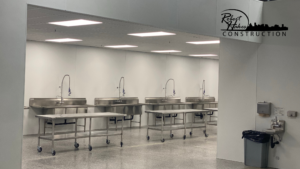Industrial real estate refers to properties used for manufacturing, warehousing, distribution, and research and development. Those looking to expand their business may find it a valuable investment opportunity. Here are five industrial ideas to get you started followed by ways to extend performance.
Manufacturing Facilities
Manufacturing facilities are industrial properties designed to house manufacturing lines, equipment, machinery, and equipment used in production. Typical features include large open spaces, high ceilings, and loading docks for shipping and receiving goods. Highways and airports are usually close to manufacturing facilities, which offers easy access to transportation routes.
Data Centers
These specialized facilities for storing, processing, and managing large amounts of data. Data centers are critical to the operations of many businesses and require custom infrastructure such as high-speed internet connections, backup power systems, and cooling to maintain peak performance.
Warehouses
Warehouses are used to store and deliver goods and can be owned or leased by companies that need additional inventory storage space. Different sizes and designs range from ordinary storage facilities to large distribution centers. They typically feature loading ramps and sectional doors for efficient product movement.
Flex Space
These multifunctional industrial property used for different purposes. It brings together production, storage, and office space in one place. Flex Space is used by small businesses seeking a flexible workspace suited to changing needs. Flex space is popular with e-commerce businesses that need warehouse and office space.
Research and Development Facilities
A research and development facility is a place where scientists conduct research, test products, and develop new products. These facilities are often located near universities and research centers to facilitate collaboration and access to talent. R&D facilities are expensive to build and operate, but they give companies investing in innovation a competitive advantage.
Understanding the different types of industrial real estate help companies and investors make informed decisions about their investments and operations. At Robert Hakes Construction, we want each new building to meet the standards that owners and tenants expect long after completion. To achieve this goal, here are the top things to do to ensure your new building stays like new for as long as possible.

Food Processing Center
Tips for Extending the Performance of an Industrial Building
Dock Equipment
Port equipment can be an expensive expense in an industrial park. When equipment fails, it results in high repair costs. Have dock equipment treated monthly and lubricated according to the manufacturer’s recommendations to avoid later costs.
Air Flow
Ventilation systems bring fresh air into the room and remove polluted air. It helps building materials such as concrete harden sufficiently. Ventilators in new buildings and existing buildings should run regularly, whether occupied or not.
Scrubber Landfills
Using a commercial floor scrubber is a standard method of cleaning large industrial estates. While these machines are efficient from a cleaning standpoint, they also produce a lot of dirty fluid. This fluid can damage piping systems and even pose a hazard to workers and the environment. Scrubber landfills alleviate these problems.
Windows
Windows installed on commercial and industrial buildings are designed to create energy efficiencies providing long-term utility savings for owners. While it may be tempting to alter the windows with blinds affixed to the frames or paint the glass to provide shade or reduce glare, those changes can affect the efficiency of the window. Consider other options first for windows such as manufacturer-approved window treatments and glare solutions. Regularly inspecting windows for cracks or breaks as well as how the sealant is performing will keep down costs.
Concrete
While most concrete will set within a week, it is important to keep chemicals and deicers out of contact with the surface for at least 12 months to avoid surface deterioration and failure.
Rooftop Maintenance
No matter the element – wind, snow, rain, or heat – the roof is always exposed and can make it the most vulnerable part of a building’s exterior. To ensure the roof performs as intended in the initial design, keep gutters and drainage systems clear always. When accessing the roof, use slip sheets or extra roofing material to protect the roof from foot traffic and/or heavy loads of other materials.
HVAC
Facility costs account for a large percentage of operating expenses for industrial building owners. Lowering energy costs can impact the bottom line and a properly maintained HVAC system is a good first place to start. Using proper manufacturer-recommended filters and changing them based on the recommended durations ensures maximum efficiency and air quality. Plus, always inspect and clean coils and cables and clear drain pans and condensation lines of obstructions. A routine professional inspection by a third-party vendor is recommended.
Caulking
Caulking seals joints or seams in structures. As a building settles, caulking may be necessary to seal small gaps to protect structures against water, air, dust, or other components. Remember to use the proper caulking material for the job. There are several varieties including: paintable vs. non-paintable and expandable vs. shrink-resistant.
Touch Up Paint
Commercial-grade paint not only offers curb appeal but also can protect materials such as wood from the elements. Commercial paint usually has a life span of five years; however, it may be shorter due to exposure or even the color selected (i.e., vibrant, and dark colors, for example, often have a shorter life expectancy than neutral colors). It’s good practice to inspect trim and surfaces after 3-4 years to gauge whether a fresh coat of paint is required.
Are you interested in learning more about how Robert Hakes Construction works with our clients on industrial projects? Contact us today! At RHC, we are known for our collaborative work with our clients, during the preconstruction and construction phases. Our goal is to create a unique and custom experience for our clients. This is how we measure success — and the experience we provide for our clients has made us the contractor of choice for local, regional, and national companies.

